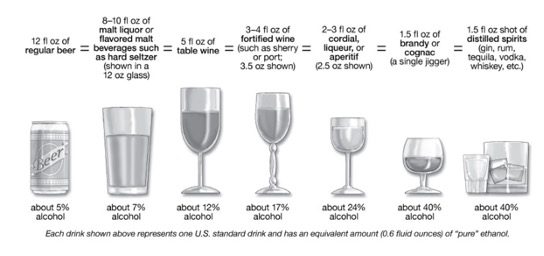By: Cathy Lau-Barraco, PhD, Licensed Clinical Psychologist at CAYA Care
Many of us enjoy a drink now and then. We may reach for that wine glass after a long day as a way to unwind or we meet up with friends for happy hour. For some of us, though, that one drink turns into many and you may find yourself asking, “Am I drinking too much?”. Before we get into the specifics of answering that question of what is “too much,” let’s first discuss what counts as a drink.
What counts as a drink?
Many people are often surprised to learn what counts as a drink. Not all drinks are created equal. Drinks often have more alcohol than people think and people tend to underestimate how much they are drinking1,2. A “standard drink” is defined in the U.S. as any drink that contains 0.6 fluid ounces or 14 grams of pure alcohol. The volume or amount of alcohol in a drink varies by the type of beverage; so different types of beer or wine could have different alcohol content.
Based on this definition, a 12 oz beer, 5 fl oz of wine, and 1.5 fl oz of spirits (e.g., vodka, tequila) are all one standard drink or one alcoholic drink equivalent. Here’s a fun fact – the ubiquitous red Solo cup that we often see is 18 oz. If filled, that’s equivalent to 1.5 standard drinks. A pina colada drink typically has 3 oz of 80 proof rum, which is equivalent to 2 standard drinks. Many craft beers have a higher alcohol by volume percentage, with one bottle being equivalent to 1.5 or even 2 standard drinks. Curious to know how much alcohol is in your favorite drink, how many calories it contains, or the cost to you per week or month? Check out these handy calculators.

What is moderate drinking?
The U.S. Dietary Guidelines advise adults who choose to drink to limit their consumption to moderate levels. That is, on days that they choose drink, limit intake to 1 drink or less in a day for women, and 2 drinks or less in a day for men3. Adhering to these guidelines will help minimize risk for harms associated with alcohol consumption. There are both short and long term health risks associated with drinking and the risk for these harms goes up the more we drink. The Guidelines note that drinking even within the recommended limits may heighten our overall risk of death from various causes, including cancer and certain cardiovascular diseases.
When is ANY drinking too much?
According to the National Institute on Alcoholism and Alcohol Abuse , a federal agency that specializes on all things related to alcohol use provides general drinking guidelines for adults. The NIAAA cautions that there is no guaranteed safe amount of alcohol for anyone4. For certain individuals, it is safest to avoid any drinking at all. This is especially true for individuals who are taking medications that interact with alcohol, have a medical condition caused or exacerbated by drinking, are pregnant or might be pregnant, are under 21, those planning to drive or operate machinery, and those recovering from an alcohol use disorder or are not able to control the amount they drink.
Ready to make a change?
Since we’re in October, consider taking on the Sober October challenge! The challenge is simply not to drink for the month. While not everyone who drinks has a problem, trying Sober October (or any other month) could help you do a check-in about your relationship with alcohol and could also help you gain awareness about the ways drinking may be impacting your life goals.
Should you decide that it is time to make a change, the help of a clinical psychologist with specialized training in this area could be very helpful. Our practice at CAYA Care offers evidence-based therapies to help individuals seeking to explore their use patterns and to figure out a treatment plan that best matches their goals.
References:
- Kerr, W.C., & Stockwell, T. (2012). Understanding standard drinks and drinking guidelines. Drug and Alcohol Review, 31(2), 200-205.
- Devos-Comby, L, & Lange J.E. (2008). “My drink is larger than yours”? A literature review of self-defined drink sizes and standard drinks. Current Drug Abuse Review, 1(2), 162-176.
- U.S. Department of Agriculture and U.S. Department of Health and Human Services. Dietary Guidelines for Americans, 2020-2025. 9th Edition. December 2020. Available at DietaryGuidelines.gov.
- National Institute of Alcohol Abuse and Alcoholism. (2023, September 22). Core Resource on Alcohol – The Basics: Defining How Much Alcohol is Too Much. Retrieved October 16, 2023, from https://www.niaaa.nih.gov/health-professionals-communities/core-resource-on-alcohol/basics-defining-how-much-alcohol-too-much#pub-toc0



